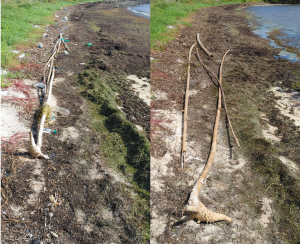Last Saturday, volunteers around the world gathered together to take part in The Ocean Conservancy’s (TOC) International Coastal Cleanup (ICC). On this one day, people around the world remove debris from shorelines and aquatic systems, catalog that data, enter it into the Clean Swell app, which TOC uses to produce it’s annual ICC reports. These reports feature a snapshot of this global collective effort.
Every year, in partnership with Biscayne National Park, I organized a cleanup that offers the opportunity to volunteers to get to know their National Park. We travel to the oceanside of Elliot Key, the largest and northernmost of the undeveloped Florida Keys, protected by the Park. Elliot Key is eight miles away from Miami-Dade County’s coast, and therefore, a giant filter for boat and shipping-based debris.
Elliot Key
Elliot Key hosts the Park’s only sea turtle nesting beaches. Not all of the island’s seven miles of shoreline is suitable nesting habitat. What is available is quite narrow, which means that the constant inundation of debris can clog up the beach quickly. For this reason, we visit these beaches for the ICC and other cleanup events. Constant maintenance of these areas is required to keep the beaches clear of debris, both for the wildlife that depend upon it, as well as the aesthetic values that they offer to park visitors.
The cleanup and results
On Saturday, six volunteers donated their day to drive to Homestead, took a 45-minute boat ride, waded through waist-deep water before they even began to remove debris. After a bit over two hours, the debris was catalogued, piece by piece, before being bagged and weighed. This process proved painstaking, as the great majority of the debris (76%) was plastic. The plastics that wash up on these beaches photodegrade quickly and shatter into smaller pieces even as they are being removed. Below is an overview of the plastic items removed:
- 673 plastic bottle caps
- 238 plastic bottles (beverage)
- 62 other plastic bottles
- 73 plastic grocery bags
- 46 other plastic bags
- 632 other plastic waste
- 293 microplastics

The weight of the debris removed totaled 141 pounds. While this may not seem extraordinary, considering that 76% of the items were plastic, it’s not a surprise as plastic itself is quite light (part of the reason it became so popular as a packaging item).
Volunteercleanup.org organizes the Miami-Dade cleanups for the ICC. The total removal for pounds removed in 2021 was 17,771. This year, that totals were more than 22,000 pounds! While it might not be the most glamorous work, marine debris removals are absolutely integral to the health and function of our coastline and must be done continuously.
Other cleanup opportunities
If you are interested in participating in a beach cleanup, Biscayne National Park offers their Alternate Spring Break (ASB) program during the winter months. ASB is quite similar to the ICC experience that we offered. To learn more about this and inquire about availability, email: BISC_Beach_Cleanup@nps.gov. Other cleanups in Miami-Dade County are continuously hosted and advertised at: www.volunteercleanup.org.
Thank you to Dylann, Marcel, Katie, Calvin, Natalie, and Jeanne!
 0
0
